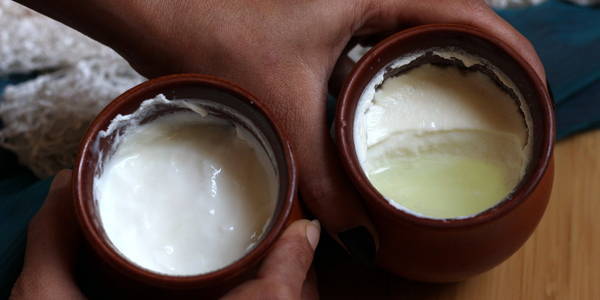(Editor’s note: Given the role of yogurt in the Indian diet, especially among vegetarians, we are publishing an article on yogurt’s health benefits from The Nutrition Source, a publication of Harvard T.H. Chan School of Public Health. The article also includes footnote and references in case our readers want to read more about this topic.)
Yogurt is a staple food in several cultures, originating from countries in Western Asia and the Middle East. The word yogurt is believed to be derived from the Turkish word “yoğurmak,” which means to thicken, coagulate, or curdle. [1] Historical accounts describe nomadic herdsmen carrying milk in pouches made of animal skins. Naturally occurring enzymes in the pouches that were carried close to the body produced enough body heat to ferment the milk, producing an edible food that lasted longer than milk; thus the introduction of yogurt!
Yogurt is made when heated milk is combined with bacteria, specifically Lactobacillus bulgaricus and Streptococcus thermophilus, and left to sit for several hours at a warm temperature (110-115°F). Additional types of lactobacilli and bifidobacteria may be added. The bacteria convert the sugar in milk, called lactose, to lactic acid, which thickens the milk and develops its distinctive tart flavor.
 References to yogurt and health date back to 6000 BCE, as seen in Indian Ayurvedic medicinal texts. In the 1900s, the Bulgarian microbiologist Stamen Grigorov discovered Lactobacillus bulgaricus bacillus, a strain of the bacillus bacteria not naturally found in the human gut that caused the fermentation of yogurt. He also researched the specific health effects of lactic acid.
References to yogurt and health date back to 6000 BCE, as seen in Indian Ayurvedic medicinal texts. In the 1900s, the Bulgarian microbiologist Stamen Grigorov discovered Lactobacillus bulgaricus bacillus, a strain of the bacillus bacteria not naturally found in the human gut that caused the fermentation of yogurt. He also researched the specific health effects of lactic acid.
Today, yogurt can be found in a variety of forms—including plain, but often with added fruit or sweeteners. Thickeners and stabilizers such as gelatin and pectins may also be added for a thicker texture and richer taste.
Individuals with lactose intolerance who cannot tolerate dairy products may be able to eat some yogurt because of its lower concentration of lactose. Fermentation by the bacteria breaks down lactose to lactic acid. Another option may be plant-based yogurts, which do not contain lactose.
Yogurt and Health
Yogurt offers several important nutrients including protein and calcium. However, much of the research on yogurt’s health benefits centers on its live bacterial content, which is also present in other fermented foods like kefir, kimchi, and sauerkraut. [2] It has been proposed that a lower number of some bacterial strains in the body may influence risk of certain disease conditions including obesity, type 2 diabetes, irritable bowel syndrome, and chronic inflammatory diseases such as Crohn’s disease, ulcerative colitis, and rheumatoid arthritis. [3, 4] A plant-based diet is associated with supporting a diverse and probably healthier gut microbiota more than a diet low in fruits and vegetables and high in meat, [5] and yogurt consumption may also help to increase microbiota diversity in the gut. [6] Learn more about the body’s microbiome.
Epidemiological research on specific health effects of yogurt is still limited but a few studies suggest a benefit. In a study following three large cohorts for up to 20 years that included 120,877 men and women free of obesity and chronic diseases at baseline, yogurt consumption appeared to protect from weight gain. [7] The authors suggested that changes in colonic bacteria from eating the yogurt may have influenced weight changes. Daily yogurt intake may also protect against heart disease and type 2 diabetes. [8-10]
Rich in
- Protein
- Calcium
- Phosphorus
- B vitamins – riboflavin and B12 (animal-based yogurt only)
Make
If you want to try making strained yogurt at home, it’s not as difficult as you might think:
- Heat 1/2 gallon of milk (may be skim, 2%, or whole). Pour the milk into a 3-quart saucepan and set over medium heat. Warm the milk until almost boiling when small bubbles appear; stir the milk periodically to prevent scorching.
- Cool the milk to a warm temperature of about 110°-115° F and transfer to a glass or ceramic bowl. A higher temperature can destroy the bacteria, while a cooler temperature can prevent fermentation.
- Whisk into the milk ½ cup plain yogurt with live cultures or a yogurt starter package. Cover the bowl with a lid or clean plate. Wrap the bowl in a towel.
- Heat oven to warm setting for 1-2 minutes and turn on oven light. Turn off the oven (leave light on) and place yogurt into oven. Let sit for at least 4 hours but may be left overnight. The oven temperature should be about 110°F.
- The yogurt is then ready to use. If you prefer this thinner consistency, refrigerate for a few hours before eating. If you wish a thicker Greek-style yogurt, strain the yogurt. Place a fine mesh sieve over a large bowl and line with a coffee filter or cheesecloth. Pour the yogurt into the sieve and refrigerate for up to several hours, which will strain out the liquid whey and excess water. The yogurt may be stored in the refrigerator for about 7 days.

Serve
- Choose plain and unsweetened yogurt, either strained or unstrained. Add herbs and spices for savory preparations, or fresh fruit and spices like cinnamon, nutmeg, or ginger for a sweeter dish. Top with almonds, pecans, or other nuts for a crunchy addition.
- For a delicious tzatziki sauce, blend together 1 whole diced peeled cucumber, 2-3 tablespoons lemon juice, 1 tablespoon extra virgin olive oil, 1 garlic clove, 1 tablespoon dill, and a pinch of salt and black pepper. Stir mixture into 3 cups of plain Greek yogurt. Serve as a sauce or a dip.
- Substitute plain yogurt in recipes calling for sour cream or mayonnaise. Examples:
- For tuna salad, use half plain yogurt and half mayo. For extra zip, try adding any of the following to taste: Dijon mustard, chili powder, garlic powder, diced dill pickles, or red onion.
- For a creamy honey mustard salad dressing or marinade, whisk together 1/2 cup 2% plain Greek yogurt, 2 tablespoons yellow mustard, 3 tablespoons honey, 1 tablespoon garlic powder, 1 tablespoon lemon juice, and pinch of salt and pepper.
Did you know?
- Greek yogurt did not originate in Greece! Although strained yogurt or straggisto is a staple dish in Greece, the term “Greek yogurt” was first made popular by a commercial yogurt company located in Greece, and later used by other U.S. and European yogurt companies. Britain is the only country that regulates the term, where yogurt must be produced in Greece to carry the title.
- Some calcium is removed from Greek yogurt during the straining process. Commercial Greek yogurts may add back calcium, but some do not so if you are including Greek yogurt in your diet as a calcium source, be sure to check the Nutrition Facts label.
- Some yogurts can contain up to 20-25 grams of sugar per 5 oz. container. Though some of this may come from naturally occurring lactose, most will be from added sweeteners. If you see sugar or other forms of sugar among the top four ingredients in the Ingredients list, consider choosing a lower sugar yogurt or use plain yogurt with your own addition of fresh fruit or a drizzle of honey.
References
- Fisberg, M., and Machado, R. History of yogurt and current patterns of consumption. Nutr Rev. (2015) 73 (suppl_1): 4-7.
- Marco, M.L., et al. Health benefits of fermented foods: microbiota and beyond. Current Opinion in Biotechnology. Volume 44, April 2017, pp 94–102.
- Walsh, J.C., et al. Beneficial modulation of the gut microbiota. FEBS Lett. 2014 Nov 17;588(22):4120-30.
- Albenberg, L.G., and Wu, G.D. Diet and the Intestinal Microbiome: Associations, Functions, and Implications for Health and Disease. Gastroenterology. Volume 146, Issue 6, May 2014, pp 1564–72.
- Jeffrey, I.B., and O’Toole, P.W. Diet-Microbiota Interactions and Their Implications for Healthy Living. Nutrients. 2013, 5(1), 234-52.
- Lisko, D.J. et al. Effects of Dietary Yogurt on the Healthy Human Gastrointestinal (GI) Microbiome. Microorganisms. 2017 Feb 15;5(1).
- Mozaffarian, D., et al. Changes in Diet and Lifestyle and Long-Term Weight Gain in Women and Men. N Engl J Med. 2011; 364:2392-404.
- Ivey, K.L., et al. Association between yogurt, milk, and cheese consumption and common carotid artery intima-media thickness and cardiovascular disease risk factors in elderly women. Am J Clin Nutr. 2011 Jul;94(1):234-9.
- Margolis, K.L., et al. A diet high in low-fat dairy products lowers diabetes risk in postmenopausal women. J Nutr. 2011 Nov;141(11):1969-74.
- Chen, Mu, et al. Dairy consumption and risk of type 2 diabetes: 3 cohorts of US adults and an updated meta-analysis. BMC medicine.1 (2014): 215.
Terms of Use
The contents of this website are for educational purposes and are not intended to offer personal medical advice. You should seek the advice of your physician or other qualified health provider with any questions you may have regarding a medical condition. Never disregard professional medical advice or delay in seeking it because of something you have read on this website. The Nutrition Source does not recommend or endorse any products.













